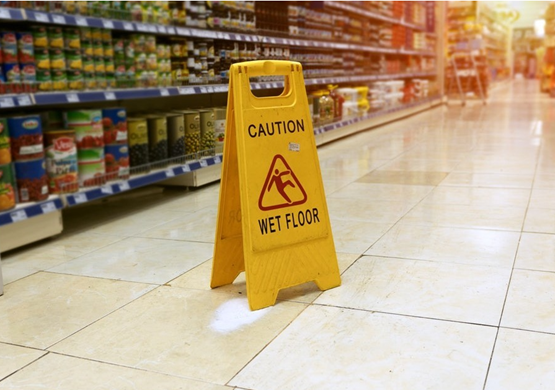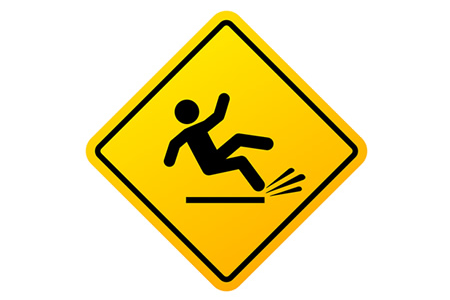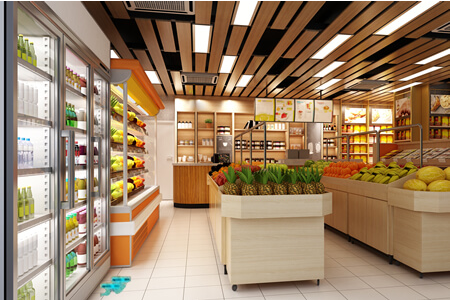Slip Trip and Fall Prevention for Managers
Understanding Effective Slip Trip and Fall Prevention
Many factors contribute to slip, trip and fall incidents. Retail management teams can better control exposures by first understanding the potential risk factors that can contribute to such incidents. Zurich carried out a forensic review of many slip, trip and fall injury cases and have identified key risk factors that can result such a claim:
• Surface composition, conditions, and changes
• Potential for foreign substances (Items to consider include ice, water, liquids, powders, grease or any substances that could be tracked into the building or accumulate on a walking surface)
• Floor or exterior walking surface height changes
• Obstructions (such as extension cords, hoses, product storage, materials handling equipment guards, concrete posts, parts of equipment, parking lot bumpers, speed bumps and temporary storage/holding areas)
• Visibility, i.e. how easy the surface is to see. (Consider glare, shadows, bright lights, colour contrasts, mist, steam, condensation, etc.)
• Human factors such as demographics, shoe type, and physically challenged persons
• Stairs
• Unusual features (i.e. alarms/buzzers, strobe or flashing lights, high pedestrian or vehicle traffic, signs, information boards, displays, large windows, and decorative lighting
The Hidden Costs of Injuries
In addition to the direct or insurable costs of a slip, trip, fall incident, there can be a variety of hidden or indirect costs. Often, these are uninsured. These can include:
• If an employee is seriously injured, time away from work
• Time spent investigating and reporting an accident
• Overtime wages paid to make up for lost production time
• Costs of hiring and training a replacement worker
• Missed deliveries/revenue
• Loss of reputation due to a serious incident
• Time spent with civil lawsuits and depositions
• Health and Safety fines, whether from OSHA in the U.S. or the HSE in the U.K.
There are, however, hidden savings in accident prevention just as there are hidden costs due to accidents. Preventing accidents saves direct and indirect costs. It can also potentially add savings to a retailer’s bottom line.
Evaluating the Risks
It’s important to know that many general liability and workers’ compensation claims indicate that slips on stairs were due to water, grease, oil, ice, snow or other liquids. Injuries can also occur on flat, dry surfaces due to clutter and obstructions. Risk specialists at Zurich recommend carrying out a survey to fully assess these top loss locations and any other location at your business where slip trips and falls have previously occurred. You should use the results of this survey to develop corrective actions in order to fine tune retail loss prevention efforts.
Opportunities for Management
Management plays a crucial role in the slip, trip, and fall prevention process. Management should set the standards for the organisation and set an example for employees. Examples of this in practice include:
• Never walk by an unsafe act or unsafe condition; model a “see it, fix it” approach - employees will determine their role in preventing incidents through leadership by example.
• Take advantage of any and every opportunity that arises to discuss slip, trip, fall safety with your team.
• Acknowledge good safety performance and celebrate success. You could do this in front of peers, on conference calls, in newsletters, or in emails.
• Create action plans to control the exposures that are identified in your organisation. Keep in mind that in most cases, more than one change is needed to affect a long-term solution to the problem.
Key Takeaways
Management has a responsibility to understand the value of slip, trip, and fall prevention and to communicate it throughout the organisation. Incorporating slip, trip, and fall awareness into the safety culture of your business can help ensure the safety of employees, contractors, visitors, and the public.
It's important to keep up with emerging technology. AI solutions that detect hazards such as liquid spills as soon as they occur can significantly reduce risk. It is predicted that this innovative technology will be commercially available this year. Ultimately, by preventing slip, trip and fall incidents, you can potentially improve your organisation’s bottom line.





